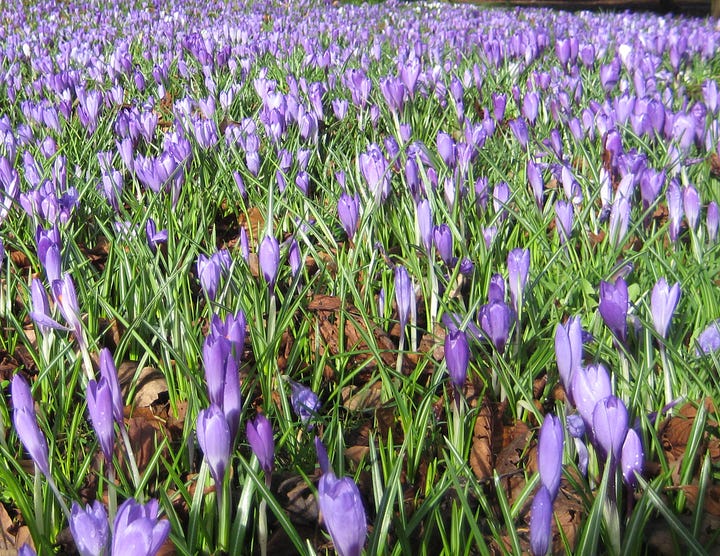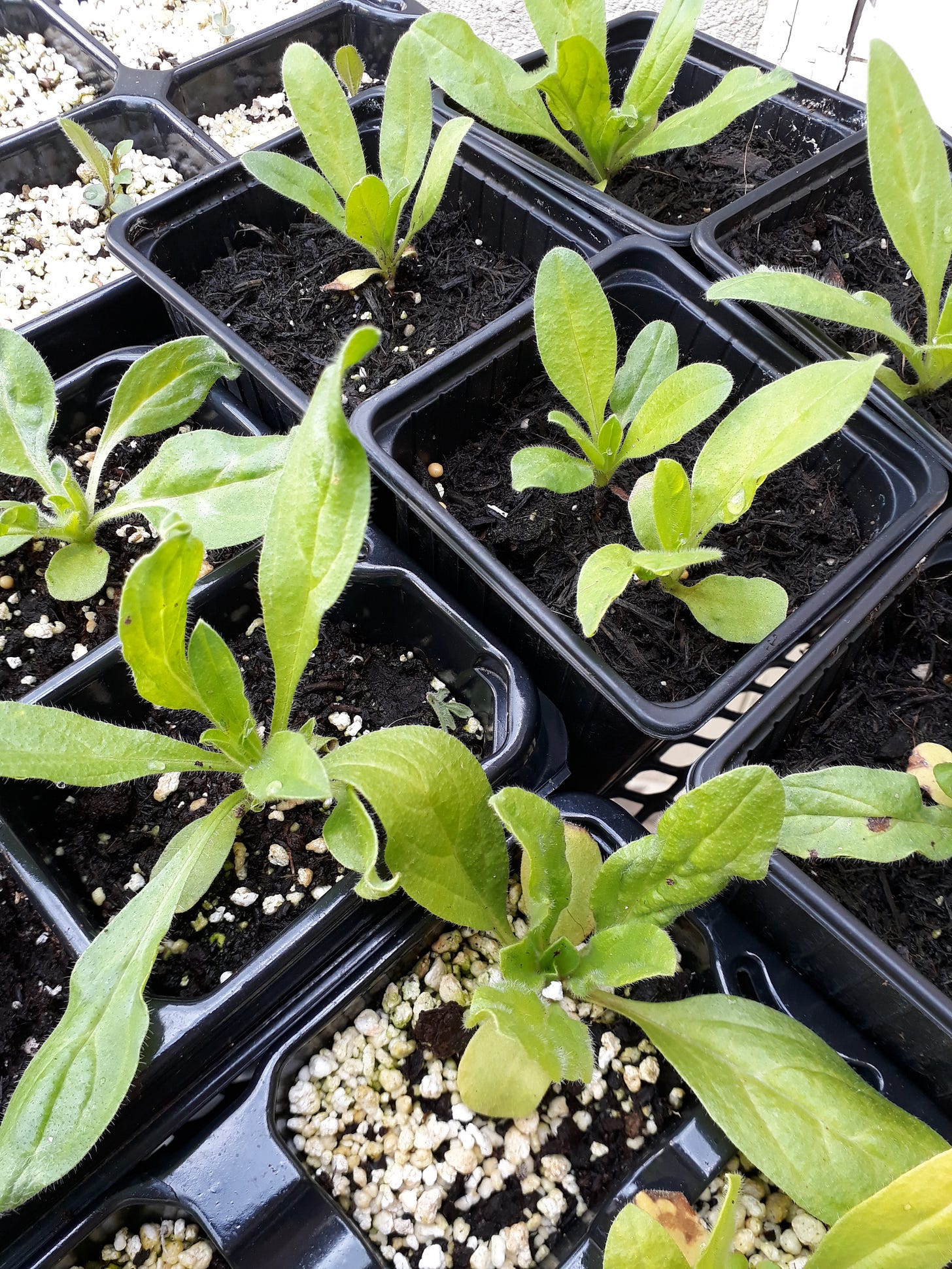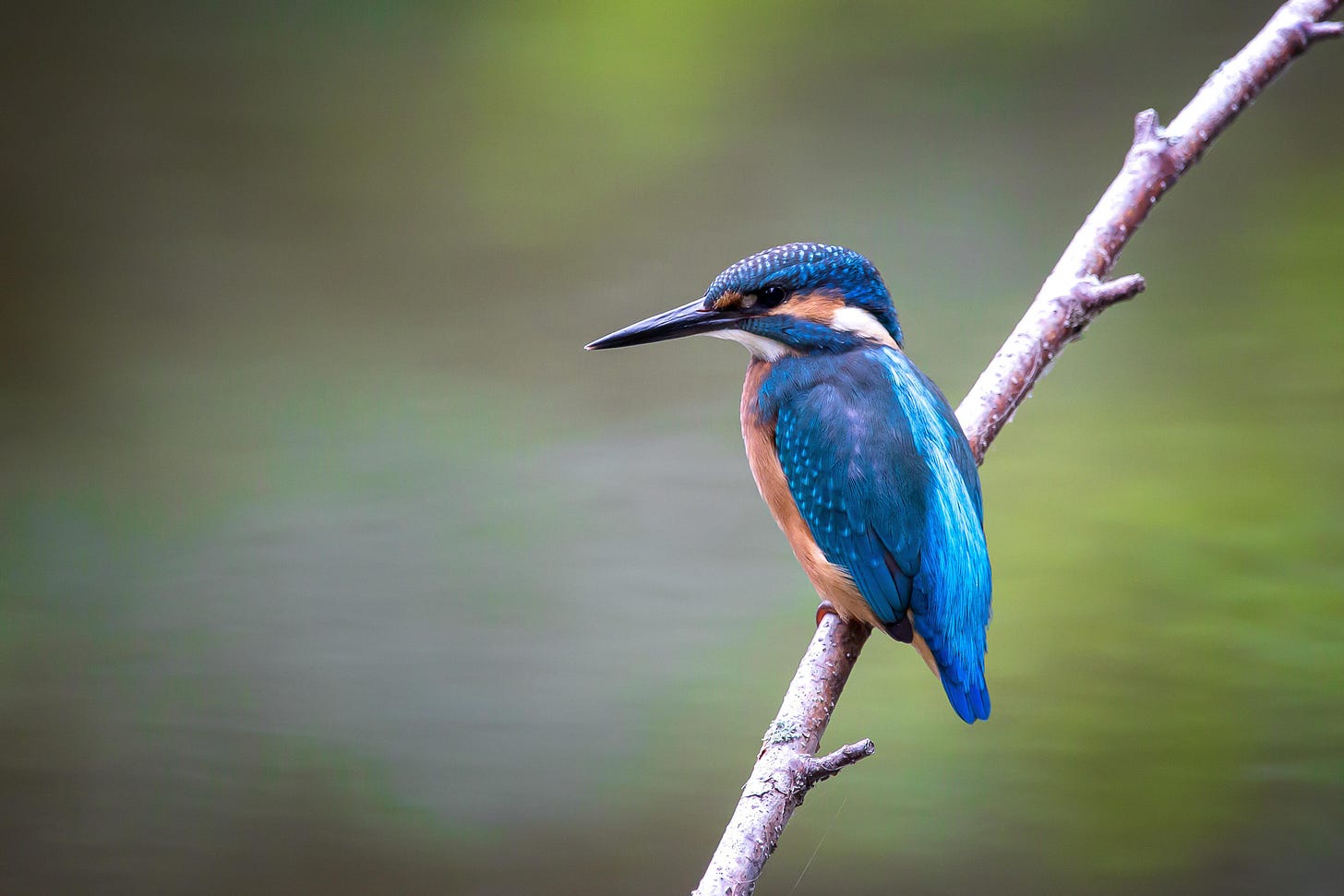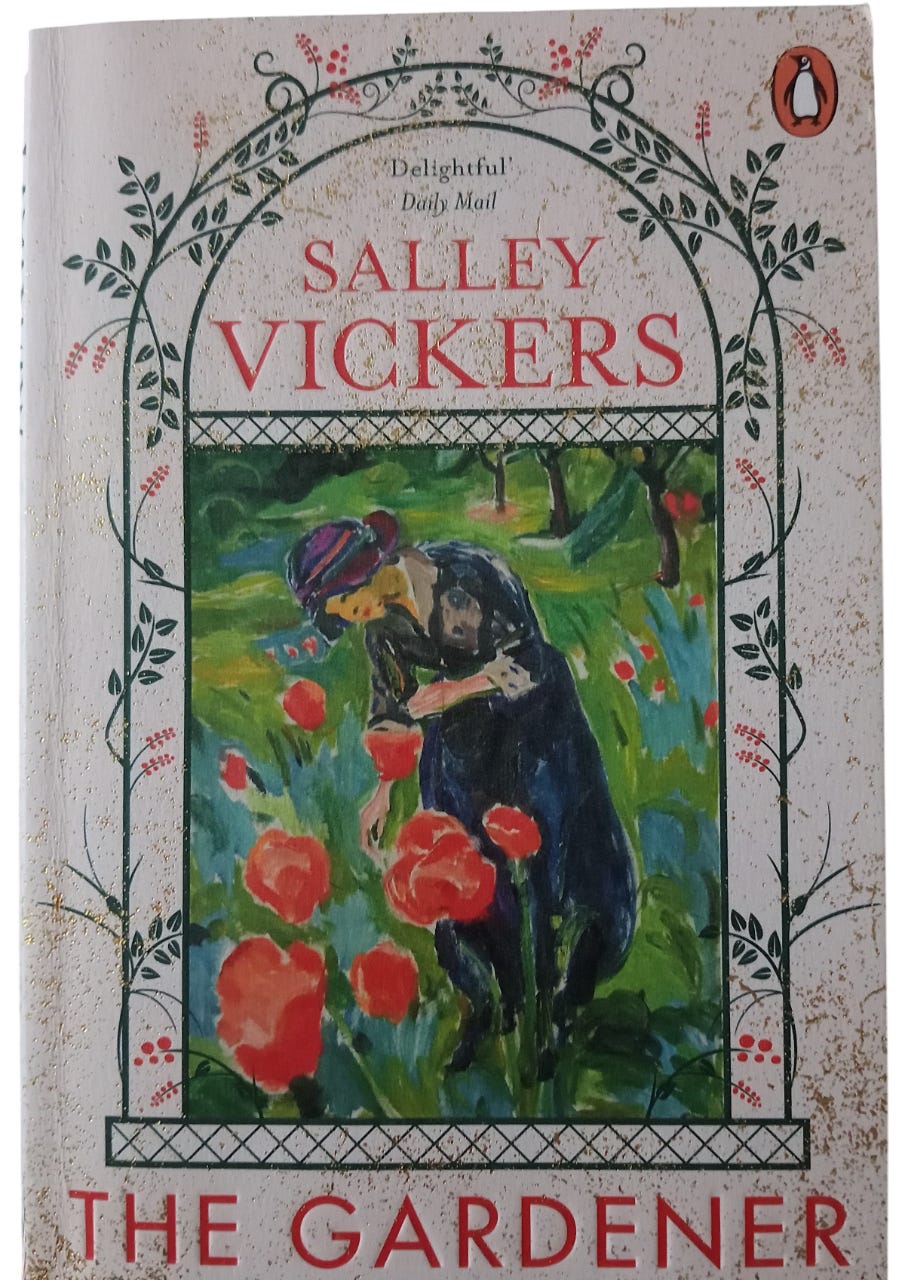February's here!
It's the 1st Saturday of the month - time for my latest set of articles, including my pollinator plant of the month, seed sowing, nature notes, and a book review.
Welcome to the first of my offerings for February. (The next batch will be posted on the 15th.)
So what’s coming up this time? We have:
· my Pollinator Plant of the Month – two actually!
· all about sowing seeds
· some jobs to be getting on with
· nature notes
· a book review
So without further ado, here are my Pollinator Plants of the Month
If I could plant only one spring-flowering bulb (or strictly speaking, corm), Crocus would be it. I had known for a while that it was attractive to pollinators, particularly honey bees.
This was overwhelmingly confirmed when I visited a park near where we used to live one spring morning. There was a carpet of crocus which had naturalised, and it was simply thrumming with bees, providing an abundance of pollen when there was little available elsewhere.


Some nectar can also be found but it is embedded deep in the base of the flower so is only available to long-tongued bees. If the nectar flow is particularly plentiful, it may rise up the corolla tube, making it accessible to other insects.
Why the preponderance of bees, though? Crocus flowers only open if the ambient temperature is 9°C or above, a temperature which is just too low for many insects to be active. Honey bees, however, will fly at 7°C, and some queen bumblebees emerging from hibernation will fly at even lower temperatures. If Crocus flowers are open, the bees will take advantage.
Do not be surprised if you find a queen bumblebee tucked up in one of the flowers having a snooze – the flowers close overnight and make a snuggly bed for a tired bee.
I am yet to discover if one species of Crocus is any better for pollinators than another, but purple-flowered ones seem to be amongst the most popular.
Like other spring-flowering bulbs and corms, Crocus should be planted in the autumn. Let’s spend a few moments going through the planting procedure. Generally speaking, all bulbs, corms and the like, should be planted three times their own depth so if your crocus corm is 3cm in height then it should be covered with 6cm of soil. But – there’s always a ‘but’ - always be guided by the planting instructions that you get when you buy your bulbs: the grower or supplier has years of experience, so take notice of what they say.
Next is Galanthus, the snowdrop. I for one take the name snowdrop for granted but it struck me as I was writing this that it really is one of those words which describes the object exactly – the little flower does indeed look like a drop of snow. The Latin name, however, is also descriptive. Carl Linnaeus, back in the 18th century, named it Galanthus, from the Greek for milk, ‘gala’ and ‘anthos’ meaning flower.
Don’t be fooled into thinking all snowdrops are the same. Like any other plant, there are a number of species, about 20 in the case of snowdrops, and upwards of 2,000 varieties. Some are so rare that they change hands for hundreds of pounds – a little bit like the Dutch tulip mania of the 17th century. In fact, in Joff Elphick’s latest ‘Galanthus Price Index’ a single bulb of the variety ‘Golden Tears’ sold for £871 – and in 2022 that same variety sold for a breathtaking £1,850! (Thanks to Joff for allowing me to use this information: his website is www.joffelphick.co.uk)
But I digress. Galanthus is one of the earliest flowering of all bulbs showing itself from January onwards in an average year. This may be way too early for a number of pollinators, but some will be out and about looking for food during late winter if the weather is clement.
Like Crocus, Galanthus respond to changes in temperature. When the air temperature is above 10°C the petals move so that the flower is open to visits by pollinating insects.
If the Galanthus like where they have been planted, they will form vast natural drifts over the years – a beautiful sight which some garden owners share when they open their gardens to the public (see below). Galanthus are best planted or transplanted ‘in the green’, meaning to plant them just after flowering and when the leaves are still green.
If you would like to visit a garden full of snowdrops have a look at the Great British Gardens website: it features an article all about where you can see swathes of these beautiful flowers - go to www.greatbritishgardens.co.uk/seasonal/snowdrops to find a venue near you.
And also visit the National Garden Scheme where they, too, have a list of gardens that are part of their scheme which have displays of snowdrops. www.ngs.org.uk/dates-for-your-diary-early-openers-2025
Next up is my topic, which this time is SOWING SEEDS
Everyone loves a bargain. Everyone loves something for nothing even more! For we gardeners, one of the easiest ways of getting something for nothing is to collect seeds. Yes, you have to have bought, or perhaps been given, the plant in the first place, but from then on it’s freebees all way. (If, however, the plant is governed by Plant Breeders Rights (PBR), you are not allowed to propagate from it in any way without a licence. And it could be, that the plant simply does not produce viable seed, like F1 hybrids.)
So, exceptions apart, sowing seed that you have gathered is a very cheap way to increase the number of plants you have. When it comes to annuals, this is really the only method to raise new plants, because, by their definition, they are ones which germinate, grow, flower, and set seed in one season. I collect annual flower seeds as a matter of course, putting them in glassine envelopes after I have cleaned and sorted them and then popping the envelope into seed packets. (I have seed collecting kits available on my website: www.thebeegarden.co.uk/product-page/seed-saving-kit)
You can raise other plants, such as perennials and even shrubs and trees, from seed but these take much longer to reach maturity. Seed sowing can be divided into two main sections: sowing seeds indoors and sowing seeds outdoors.
Sowing seeds indoors
Indoor sowing is suitable for a number of plants, both hardy and tender ones which can be started off and grown on inside so that they have a ‘head start’ when they are planted out in the garden when the weather is warm enough. Many vegetables benefit from indoor sowing, too, such as runner beans, tomatoes and courgettes. You can start sowing these in February or March.
The container you use will depend on the size of the seed. Small seeds can be sown into shallow trays and then when they are big enough they can be transplanted into bigger pots. Larger seeds can be sown into trays with individual modules which causes less disruption to the root system when you replant them. Very large seeds can have their own individual 9cm diameter pots right from the word go.
You can mix your own seed-sowing compost but I find that a proprietary compost which is specially formulated for seeds is the best: it is sterile and is not nutrient-rich. Fill your container with compost and gently firm it down. It is best to water at this stage: if you water after you have sown the seed, the water may wash the seed together, especially if it is fine. Small seeds can be scattered across the surface of the compost; larger seeds can be pushed into the surface. I then like to cover the seeds with perlite or vermiculite, rather than compost. These provide sufficient coverage without staying too moist.
Now all you need to do is cover the container with clear polythene, a sheet of glass, or its own plastic cover and put it in a warm place but you don’t need an elaborate greenhouse for this; anywhere with a fairly constant temperature and out of drafts will suffice. Much to my husband’s chagrin I use my kitchen window sill (he’s a very tidy person; I’m not): you can keep a constant eye on your ‘babies’ and you would be surprised how many small seed trays you can fit on it!
Once the seeds have germinated you can remove the cover so that the seedlings have good ventilation. When they have their first ‘true’ leaves you can pot them on into individual modules or 9cm pots respectively, depending on whether they started off in trays or modules. (The picture shows Echium ‘Blue Bedder’ seedlings.)
You can use multi-purpose compost for this task, although I like to supplement it by putting a chicken manure pellet near the bottom of the module or pot to give the plant a little more in the way of nutrients as it grows. As soon as the plants are big enough, and the risk of frosts has disappeared, you can start hardening them off. This means gradually getting your babies used to the outside world. The easiest way to do this is to begin by putting them outside in a sheltered spot during the day and then bringing them back under cover at night. As the plants begin to ‘toughen up’ you can leave them outside all the time, but you must still give them some protection at night by covering them with some horticultural fleece. The hardening off process should take between two to three weeks, depending on the weather, by which time pesky frosts will be but a memory and the plants will be strong enough to be planted out in the garden.
Sowing seeds outdoors
Many seeds are best sown straight into the soil. You can sow seed outdoors as long as the soil is warm and moist, and the air temperature isn’t too high, which is practical terms means either mid spring to early summer, or late summer to early autumn.
It’s vital to have a good seedbed, free of weeds and with a fine tilth (think of the trays that you prepared for sowing indoors). With the corner of a hoe or rake make a drill, or shallow depression, in the soil, the depth of which will depend on the seed you are sowing: generally speaking the bigger the seed, the deeper it is planted. Then water the drill. Scatter or place the seed evenly along the drill and then cover the seed with a thin layer of soil.
You will need to check occasionally if the seeds need any water. If you have sown the seeds too thickly, you may need to thin them out when they are big enough. This simply means removing seedlings so that you are left with single plants, evenly spaced, with enough room between each for them to grow on. How far apart this should be will depend on the eventual size of the plant: for example, a pot marigold (Calendula) can be spaced about 20cm apart, whereas a courgette plant needs about a metre of space.
Labelling
Whenever you take cuttings, divide plants, sow seeds - in fact anything that involves putting something into a pot or tray - make sure you LABEL IT. This is of such vital importance that it deserves to be in capital letters. No matter how good your memory is, I guarantee that you will have no idea what you put in which pot in even three weeks’ time, never mind three months.
While we’re talking about seed sowing, here are some more…
JOBS FOR FEBRUARY
February is a good time to prune Buddleja davidii – the aptly named butterfly bush. Too many people don’t prune it at all and end up with tall, straggly, woody stems with a few flowers perched on the ends. You can be quite brutal with Buddleja davidii, cutting it right back to about 30cm above the ground, just above a bud or growing shoot. A word of warning: Buddleja alternifolia and Buddleja globosa flower on the previous growing season’s stems so if you cut them back in spring you will lose all the flower buds.
You can carry on planting bare-root roses, other deciduous shrubs, hedging and trees. They are still in their dormant state – unless we’ve had a particularly mild spell.
There is still time to take root cuttings from plants such as Eyngium planum and Phlox paniculata. Carefully dig up the parent plant, keeping intact as much root as possible. With a sharp knife cut off vigorous roots as close to the crown as you can, but do not remove more than a third of the root system from the parent plant otherwise it will struggle when you replant it. Cut each root into 3-10cm lengths (the thinner the root, the longer the cutting should be), place them on the surface of a prepared tray of potting medium about 4cm apart, and cover them with a thin layer of compost. Put them in a sheltered position - a cold frame is ideal - and when there are signs of growth and the cuttings are well rooted, pot them up individually to grow on.
If you left them over winter for wildlife or as visual interest, now is the time to cut back perennials if new shoots are beginning to emerge. Cut all the old growth back to the base.
Old canes of autumn fruiting raspberries can also be removed now. Cut them down to ground level. New canes will appear which will carry this year’s fruit.
Perennial vegetables, such as asparagus, artichokes, and Jerusalem artichokes can be given a good layer ( 5-10 cm) of well-rotted manure or garden compost. This will improve the soil, suppress weeds and retain moisture.
Time for my NATURE NOTES with the focus on the Kingfisher
Although February is the shortest month by up to three days, it often feels the longest. The celebrations of Christmas and the New Year are distant memories, and we’ve made it through January. However, there still seems to be an inordinate amount of time before we can say that Spring has sprung so we need something to cheer us up.
My daily walk takes me around the perimeter of a reservoir quite close to where we live. And that’s where I saw it. A flash of almost iridescent blue. Unmistakable. But I still had to do a double-take. There was no doubt about it. A kingfisher! My heart leapt. And I think I even called out. It’s years since I saw one – and our local reservoir was the last place I expected to see one again.
It got me wondering as to why it was there in the first place. Apparently, at this time of year adults look for different stretches of water to occupy until the breeding season begins. It could be that ‘my’ kingfisher was checking out the terrain for a suitable des-res. I wonder if it will find a permanent home here.
Formerly known as Halcyon, the Kingfisher is surrounded by myths and legends. One such is from Greek mythology. Alycone was the daughter of the wind god Aeolus. After her husband died in a shipwreck, the grief-stricken Alycone dived into the ocean to be with him. But the gods took pity on them and turned them both into kingfishers so that they could continue to dive into oceans, lakes and rivers together for eternity. And as an added bonus, each year when the pair nested, Aeolus soothed the waters so that they could have a period of calm to raise their young. Hence the phrase ‘Halcyon days’ which has come to mean any time of peace and contentment, often in the past.
REVIEW
Each month I will be recommending a book, poem, painting or piece of music, each one having something to do with gardening or wider nature.
This month I’ve chosen The Gardener by Salley Vickers. Penguin, 2022 (First published by Viking, 2021) which, incidentally, has a link to the subject of my Nature Notes, above.)
I was drawn by the title, and by the beautiful cover of the paper-back book, which features a painting by Edvard Munch Woman with Poppies. In this case you can judge a book by its cover.
The unconvincingly named Halcyon Days, otherwise known as Hassie, has bought a house with her sister, Margot in Hope Wenlock in the Welsh Marches. It, along with the garden is in need of some tlc. However, Margot, who works in finance, carries on with her life in London and leaves artist Hassie to breathe life into the property again.
We learn about Hassie’s past – a mixture of sibling rivalry, an unsatisfactory love affair and the grief over the death of her father – all of which she has struggled to come to terms with.
The gardener of the title is Murat, a local Albanian immigrant hired by Hassie to help her bring some sort of order to the garden.
As the novel progresses, much is healed and restored. Psychologically, Hassie sees the possibility of a new life, free from the troubles of her past. And physically, the house gradually becomes a home where both Hassie and Margot feel settled.
The greatest physical change, however, is in the garden where Hassie and Murat work side-by-side to transform the neglected wilderness into a flourishing garden, replete with flowers and a vegetable harvest.
By the way, it strikes me that Vickers must be a well-versed gardener herself. She writes of: ‘Deep apricot rambling roses entangled with apple-scented eglantine,’ and ‘A crimson tree peony had appeared out of nowhere and shot up above the spires of sapphire delphiniums. Bees were already busily prospecting in the freckle-throated foxgloves.’ Lovely.
All in all, as critic Elizabeth Howcroft1 has commented: ‘The Gardener is a tender manifesto for how what is broken and neglected in us can be restored through care, love and time.’
And I can’t help but be reminded of Voltaire who ends his 1759 novel Candide with the lines: ‘We must cultivate our garden’. I regard this as meaning: look to our own doings and surroundings – care for, and nourish them and they, like a well-tended garden, will thrive.
1. Howcroft, Elizabeth (2021) ‘Coming into Bloom’ in Literary Review, November 2021.
Picture credits:
Crocus with bee, Snowdrop, Kingfisher: Pixabay. All others: my own
For more information about The Bee Garden and what I get up to, please have a look at my website www.thebeegarden.co.uk which also features my online shop. And as a thankyou for signing up to receive these articles you can get a 10% discount on all items in the shop: simply enter SUB10 at the checkout and the discount is automatically activated.










